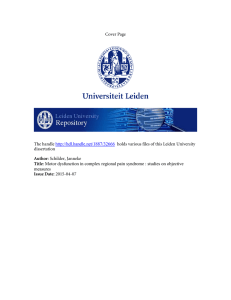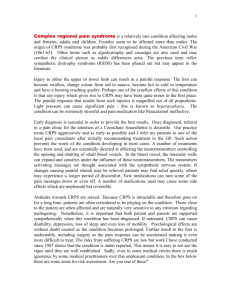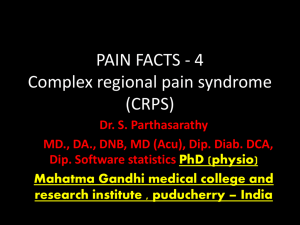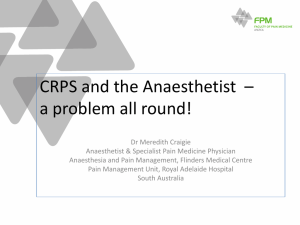Managing patients with chronic pain
advertisement
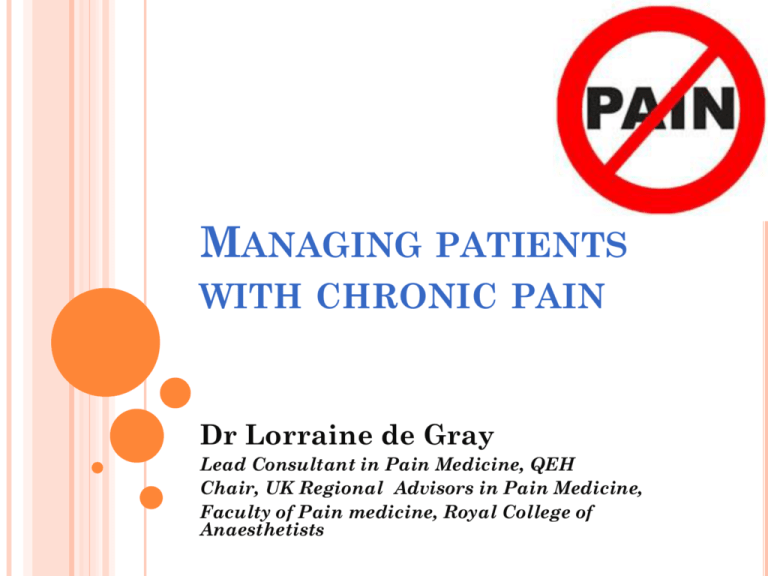
MANAGING PATIENTS WITH CHRONIC PAIN Dr Lorraine de Gray Lead Consultant in Pain Medicine, QEH Chair, UK Regional Advisors in Pain Medicine, Faculty of Pain medicine, Royal College of Anaesthetists BACK PAIN - A SLIPPERY SLOPE CASE SCENARIO 1 IE is a 55 year old male who presents with a four month history of intractable low lumbar back pain. He is struggling to work (accounts clerk) He has tried over the counter analgesics His wife has made him come and see you What questions would you ask? USEFUL TO KNOW: Type of pain Radiation? Referral? Weight loss? What makes it better? Sitting, standing, walking? Any bladder symptoms Any other relevant clinical symptoms? Any relevant past medical history Any relevant past medical history Smoker? INFLUENCES ON THE PAIN EXPERIENCE Age Fear s Education and understandin g Gende r Pai n Previous pain experience (self/family) Culture EXAMINATION Paraspinal spasm low lumbar bilaterally Pain worse on extending the spine Lower limbs normal power, sensation, reflexes Positive straight leg raise at 60 degrees bilaterally Looks well otherwise Outcome measures Oswestry Roland Morris PHQ 9 HADS WHAT DO YOU DO? WHAT DO YOU DO? Reassure Simple analgesics, NSAIDS +/- muscle relaxant Heat Physiotherapy/Manual therapy via back pain pathway Review in four weeks FOUR WEEKS LATER No better Off work “Physiotherapy made me worse” His wife comes with him and says you have to sort him out. What do you do? RED FLAGS Gross neurology Sphincter disturbance Saddle anaesthesia Up going planters Weight loss History of malignancy Recent significant trauma Severe thoracic back pain Severe bilateral leg pain Spinal deformity Severe constant night pain Gait disturbance Fever or night sweats YELLOW FLAGS Personal Fear avoidance Pessimism depression, expressed stress, anger and sometimes sleeplessness Illness behaviour and adoption of the sick role Passivity (external locus of control) Helplessness Tendency to see pain in a catastrophic light Family: beliefs, expectations, reinforcement Work: job satisfaction, difficulty working with pain, flexibility of employer, work options Non-health problems (financial, marriage?) Mobility and function Hobbies and pleasures. Restrictions PAIN CLINIC Undiagnosed back pain Likely mechanical Need to exclude sinister underlying cause Need to help patient understand why he has pain Take history Examine What do I do? BEST TOOL Why Does The Patient Hurt? BLOOD TESTS Full blood count Bone profile PSA Serum protein electrophoresis – Bence Jones proteins CRP ESR IMAGING?? MRI Any scan or REASSUROgram point in doing a lumbar spine X-ray? Invalidism Sick leave Avoidance Chronic Depression Helplessness Failed treatment Anger &blame Catastrophising Uncertainty & fear Acut e OBJECTIVES OF CHRONIC PAIN MANAGEMENT Alleviate pain Alleviate psychological and behavioural dysfunction Reduce disability and restore function Rationalize usage of medicines Reduction of utilization of health care services Attention to social, family and occupational issues MANAGEMENT PLAN Explain, explain and explain again Look at medication – is it nociceptive, neuropathic or mixed pain Practical pain management advice ?Intervention – role of facet joint injections Back programme Support Back to work, ergonomics, employment support LUMBAR FACET JOINT INJECTIONS TO INTERVENE OR NOT TO INTERVENE? Spinal injections are simply a way of giving patients a window of pain relief. They are not a long term fix. Even a successful denervation will not last more than eighteen months as a procedure in its own right. Patients need multidisciplinary input aimed at improving their pain management skills Pain Management Advice seminars Back Programme Individual physiotherapy (including hydrotherapy) Individual psychotherapy SUGGESTED READING Back Pain Revolution: Gordon Waddell 2004 2nd edition British Medical Journal – EDITORIAL Red flags for back pain BMJ 2013; 347 doi: http://dx.doi.org/10.1136/bmj.f7432 (Published 12 December 2013) NICE guidelines – CG 88 (2009) WIDESPREAD BODY PAIN CHRONIC FATIGUE SYNDROME CASE PRESENTATION 33 year old woman Five year history of widespread body pain Chronic headaches, irritable bowel, irritable bladder Low mood Constant fatigue, can’t do anything, can’t concentrate, can’t sleep Joints feel swollen, non dermatomal upper and lower limb pain Tried a variety of analgesics and antidepressants – none help Unable to cope at home, two small children, partner unsympathetic DIFFERENTIAL DIAGNOSIS Inflammatory arthropathy Polymyalgia rheumatica Somatiform disorder/primary mental health problem Hypothyroidism Lyme’s disease MAJOR CHALLENGES Lack of trust in the medical system Multitude of symptoms Yellow flags Keep an open mind Manage in a holistic way Engage multidisciplinary pain management Neuropathic medication Physiotherapy to improve level of function Psychology: group, individual Occupational therapy Complementary therapy – TENS, acupuncture Where appropriate involve mental health services Fibromyalgia Support groups SUGGESTED READING Arnold LM, Sarzi-Puttini P, Arsenault P, et al. Efficacy and safety of Pregabalin in patients with fibromyalgia and co-morbid depression receiving concurrent antidepressant therapy: a randomized, 2-way crossover, double-blind, placebo-controlled study [abstract L6]. Presented at: American College of Rheumatology (ACR) 2013 Annual Meeting; October 29, 2013; San Diego, California. Available at https://ww2.rheumatology.org/apps/MyAnnualMeeting/Abstract/39039. Accessed November 11, 2013 Yunus MB. Fibromyalgia and overlapping disorders: the unifying concept of central sensitivity syndromes. Semin Arthritis Rheum. Jun 2007;36(6):339-56. [Medline]. Gracely RH, Petzke F, Wolf JM, Clauw DJ. Functional magnetic resonance imaging evidence of augmented pain processing in fibromyalgia. Arthritis Rheum. May 2002;46(5):1333-43. [Medline]. Wolfe F, Clauw DJ, Fitzcharles MA, et al. The American College of Rheumatology preliminary diagnostic criteria for fibromyalgia and measurement of symptom severity. Arthritis Care Res (Hoboken). May 2010;62(5):600-10. [Medline]. Crombez G, Eccleston C, Van den Broeck A, et al. Hypervigilance to pain in fibromyalgia: the mediating role of pain intensity and catastrophic thinking about pain. Clin J Pain. Mar-Apr 2004;20(2):98-102. [Medline]. NEUROPATHIC PAIN ?CAUSE SPEED IS OF THE ESSENCE CLINICAL PRESENTATION 35 year old female otherwise healthy Trapped her left index finger in a door a two weeks ago. At the time, finger bruised, treated with cold compress, and simple analgesics She comes to see you, complaining of severe pain in her left finger and hand. The pain is burning in nature and keeping her awake What do you ask? CLINICAL SCENARIO COMPLEX REGIONAL PAIN SYNDROME CRPS type I requirements feature causation by an initiating noxious event, such as a crush or soft tissue injury; or by immobilization, such as a tight cast or frozen shoulder. CRPS type II is characterized by the presence of a defined nerve injury. Both types demonstrate continuing pain, allodynia, or hyperalgesia that is usually disproportionate to the inciting event. IASP REVISED CRITERIA FOR CRPS Continuing pain that is disproportionate to any inciting event At least 1 symptom reported in at least 3 of the following categories: Sensory: Hyperesthesia or allodynia Vasomotor: Temperature asymmetry, skin colour changes, skin colour asymmetry Sudomotor/oedema: Oedema, sweating changes, or sweating asymmetry Motor/trophic: Decreased range of motion, motor dysfunction (eg, weakness, tremor, dystonia), or trophic changes (eg, hair, nail, skin) IASP REVISED CRITERIA FOR CRPS At least 1 sign at time of evaluation in at least 2 of the following categories: Sensory: Evidence of hyperalgesia (to pinprick), allodynia (to light touch, temperature sensation, deep somatic pressure, or joint movement) Vasomotor: Evidence of temperature asymmetry (>1°C), skin colour changes or asymmetry Sudomotor/oedema: Evidence of oedema, sweating changes, or sweating asymmetry Motor/trophic: Evidence of decreased range of motion, motor dysfunction (eg, weakness, tremor, dystonia), or trophic changes (eg, hair, nail, skin) No other diagnosis better explaining the signs and symptoms COURSE OF CRPS The severity rather than the aetiology seems to determine the disease course. Age, sex and affected side are not associated with the outcome . Fractures may be associated with a higher resolution rate (91%) than sprain (78%) or other inciting event (55%) . A low skin temperature at the onset of the disease may predict an unfavourable course and outcome A retrospective analysis of 1006 CRPS cases, mostly female, and younger patients with CRPS of the lower limb showed an incidence of severe complications in about 7%, such as infection, ulceration, chronic oedema, dystonia and/or myoclonus RECURRENCE OF CRPS In 1183 patients (Veldman et al) the incidence of recurrence was 1.8% per year. The patients with a recurrent CRPS were significantly younger but did not differ in gender or primary localization. The recurrence of CRPS presents more often with few symptoms and signs and spontaneous onset. SPEED IS OF THE ESSENCE WITH CRPS Urgent referral to pain clinic Physiotherapy: Desensitization, graded motor imagery Medication Sympathetic nerve block: Stellate ganglion block Occupational therapy Neuromodulation Ongoing trials with immunoglobulin GRADED MOTOR IMAGERY Step 1 - Laterality Reconstruction Quite often, people with painful limb problems lose the ability to recognise left or right images which can obstruct a successful recovery. The good news is the brain is plastic, and changeable, if given the right stimuli for long enough. So with a little bit of work, patience and persistence it is possible to reconstruct the brain’s feature of laterality, which would have existed prior to the limb problem. Step 2 - Motor Imagery Around 25 percent of the neurons in your brain are called ‘Mirror Neurons’ and are activated when you watch someone else moving or think of performing an action. Motor Imagery is the process where you observe others’ actions or positions and copy them in your head without actually moving. The brain is being exercised and retrained with no motion required. Part 3: Mirror therapy This is the use of a mirror to present the reverse image of a body part limb to the brain. It is also the final stage of Graded Motor Imagery because there is evidence that mirror therapy will be more effective if your sense of laterality is intact By using a mirror, you can trick the brain into believing that an injured part is actually okay, providing a powerful synaptic exercise. For example, if the left hand was a problem, it could be hidden behind the mirror. And by using the mirror image of the right hand and concentrating on the mirror image, the brain would construct that the left hand was now somehow okay. It is a way of signalling to the brain that ‘the hand is fine, it’s now time to represent it properly and look after it.’ http://www.rcplondon.ac.uk/sites/default/files/documents/complex-regional-painfull-guideline.pdf FUNCTIONAL ABDOMINAL PAIN HEART SINK PAR EXCELLENCE CLINICAL SCENARIO 23 year old university graduate presents with unexplained abdominal and pelvic pain. She has had extensive gastrointestinal, gynaecological and urological investigations. Pain is unremitting associated with nausea, pallor, and intermittent diarrhoea or constipation. She is jobless, unable to seek work because she is in too much pain. She is low in mood and accompanied by her mother who is very concerned about her. How do you manage her? HOW DO YOU MANAGE HER? Take a history Ensure patient feels she is believed Think outside the box Take a good psychosocial history Useful outcome measures Brief pain inventory Pain catastrophizing scale THINK MULTIDISCIPLINARY Hyper vigilant gut Think neuropathic Think desensitisation Think complementary Think psychology Think Hypnotherapy Think occupational therapy VISCERAL PAIN Visceral pain is the most frequent form of pain, felt by most people at one time or another the number one reason for patients to seek medical attention. it is insufficiently treated as it is considered just a symptom of an underlying disease many forms of visceral pain are diseases in their own right and require focused and specific therapies IASP CLASSIFICATION OF VISCERAL PAIN Visceral and other chest pain Chest pain of psychological origin Chest pain referred from the abdomen or gut Abdominal wall pain Abdominal pain of visceral origin Abdominal pain of generalised diseases Chronic pelvic pain syndromes Diseases of the pelvic organs Pain in the rectum, perineum and external genitalia SIMPLER CLASSIFICATION OF VISCERAL PAIN Organic abdominal pain Functional gastrointestinal disorders Defined as a ‘variable combination of chronic or recurrent gastrointestinal symptoms which are not explained by structural or biochemical abnormalities’ HYPNOTHERAPY IN IRRITABLE BOWEL SYNDROME J Psychosom Res. 2008 Jun;64(6):621-3. doi: 10.1016/j.jpsychores.2008.02.022. Epub 2008 Apr 28. Hypnotherapy for irritable bowel syndrome: the response of colonic and noncolonic symptoms. Whorwell PJ. CG61 Irritable bowel syndrome: NICE guideline 08 October 2012 1.2.3.1 Referral for psychological interventions (cognitive behavioural therapy [CBT], hypnotherapy and/or psychological therapy) should be considered for people with IBS who do not respond to pharmacological treatments after 12 months and who develop a continuing symptom profile (described as refractory IBS). SUGGESTED READING LIST IASP clinical updates – Visceral Pain, Vol XIII, No 6, December 2005 Visceral Pain, Cervero et al, THE LANCET • Vol 353 • June 19, 1999 Gut pain & visceral hypersensitivity published online 21 March 2013 British Journal of Pain Adam D Farmer and Qasim Aziz http://bjp.sagepub.com/content/early/2013/03/19/2 049463713479229 Central sensitisation in visceral pain disorders, Moshiree et al, GUT, 2006 July; 55(7): 905–908 CLINICAL SCENARIO Mr XX is a 65 year old gentleman scheduled to undergo a left below knee amputation. Two years ago, he was involved in a work related incident when his left foot was mangled in machinery. Despite five attempts at surgical reconstruction of the foot, the patient remains in severe pain with a foot that is structurally unsound. In the interim he has also undergone a right total knee replacement which remains rather painful to date. Clinically he has signs and symptoms of uncontrolled neuropathic pain and he has pleaded with the surgeon to amputate his foot. CLINICAL SCENARIO: PAST MEDICAL HISTORY He has an aortic abdominal aneurysm (40mm) under annual surveillance He has a history of chronic lumbar back pain for which he had attended the pain clinic in the past (prior to the accident) He had one episode of dvt many years previously after undergoing a knee arthroscopy He has an ongoing personal injury claim He is also awaiting trial at the high court for unrelated offences CLINICAL SCENARIO Medication/other treatment: Fentanyl 87 micrograms per hour patch Oramorph up to 120mg per day Duloxetine 60mg am, 30mg pm Pregabalin 300mg bd Paracetamol Clexane 40mg daily (ever since the accident) Ramipril, Bendrofluazide, Simvastatin Graded motor imagery Beckham boot Desensitisation therapy FENTANYL MORPHINE EQUIVALENT Fentanyl 12 = Morphine 45mg per day Fentanyl 25 = Morphine 90mg per day Fentanyl 50 = Morphine 180mg per day Fentanyl 75 = Morphine 270mg per day Fentanyl 100 = Morphine 360mg per day HOW WOULD YOU MANAGE THIS PATIENT POINTS TO CONSIDER Preventive analgesia Regional anaesthesia Polypharmacy – significant amount of opiates Management of pain post-operatively Stump pain Phantom pain Likely recurrence of back pain Ongoing psychological stresses Need for Clexane ANY QUESTIONS? THANK YOU FOR LISTENING
